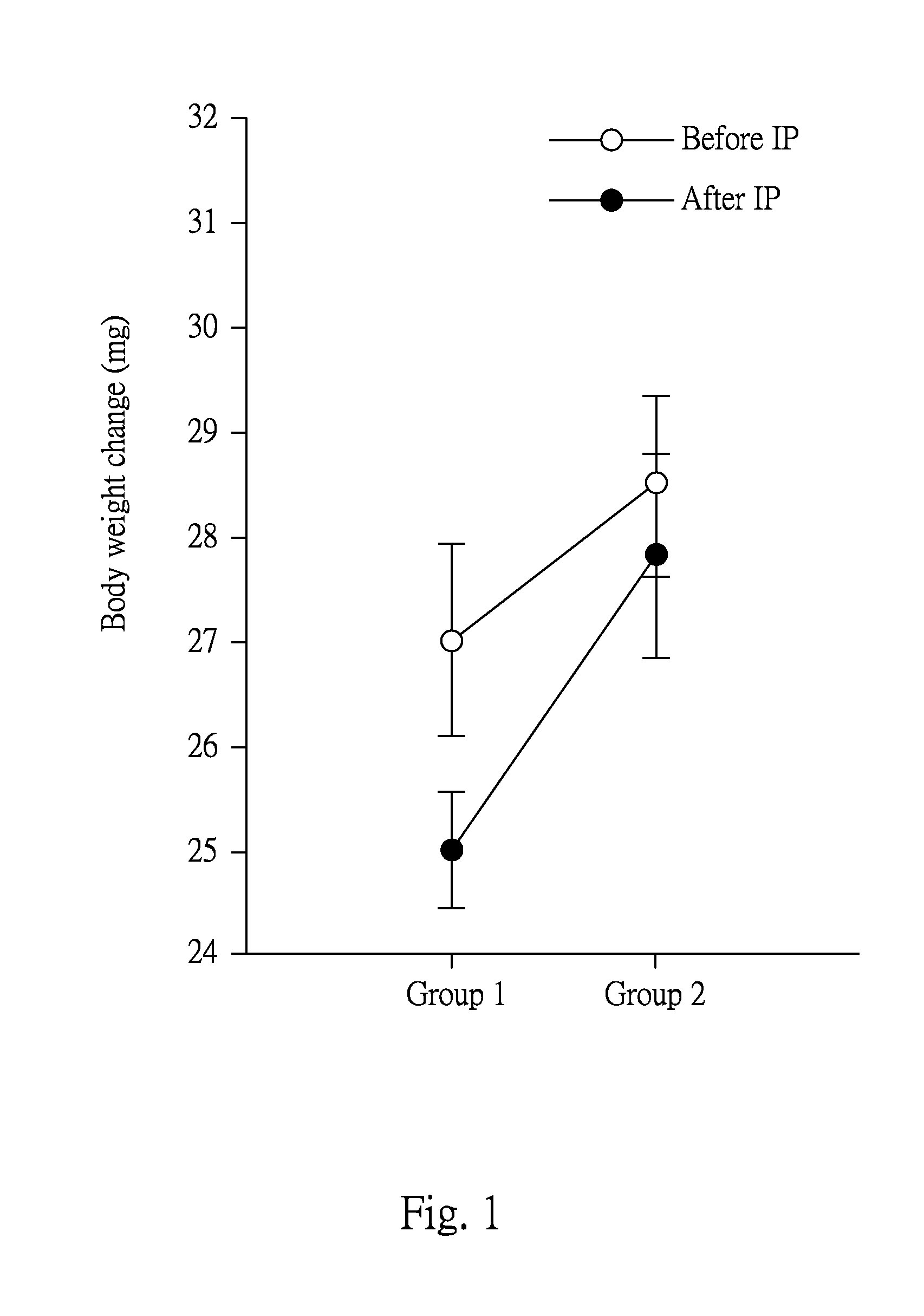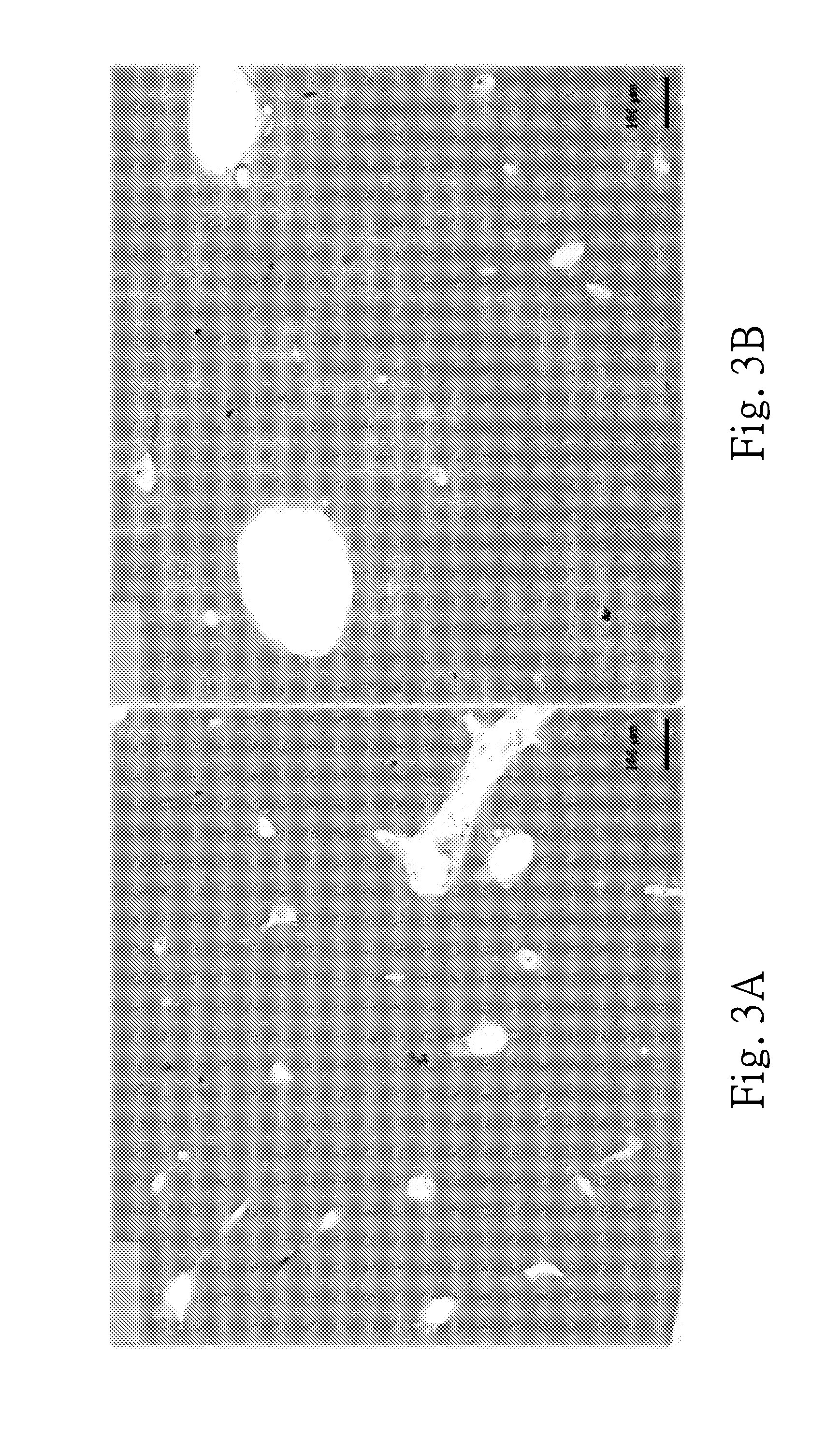Method for treating or preventing liver related diseases
- Summary
- Abstract
- Description
- Claims
- Application Information
AI Technical Summary
Benefits of technology
Problems solved by technology
Method used
Image
Examples
example 1
Animal Experiments
[0054]The experiments using the experimental mice were conducted according to the IACUC-100-12 protocol approved by Academia Sinica Institutional Animal Care and Utilization Committee (IACUC) ethics committee. All C57BL / 6 male mice (6-weeks-old) were randomly divided into 5 groups that contain 8 mice in each. These mice were individually housed in a room temperature at 24±2° C. and 55±10% humidity with 12 hours of light cycle. Herein, the control mice in the group 1 were fed with standard laboratory diet and administrated 0.9% normal saline by intra-peritoneal injection. In the group 2, the mice were fed with high-fat diet to induce the fatty liver, and administrated 0.9% normal saline by intra-peritoneal injection. In the group 3, the mice were fed with high-fat diet and administrated with peptide of SEQ ID No.1 by intra-peritoneal injected with the dose of 5 mg / kg / day. In the group 4, the mice were fed with high-fat diet and administrated with peptide of SEQ ID N...
example 2
Analysis of the Composition of Fat in Mice
[0056]The blood samples collected from the mice in each group indicated in example 1 into the microcentrifuge tubes containing heparin (10 μL, 1000 IU / ml). The blood plasma was separated by centrifugation at 10000 rpm for 10 minutes. The concentration of low density lipoprotein-cholesterol (hereafter referred to as LDL) and triglyceride in the isolated blood plasma from the mice in the each group were determined by using the commercial detection kit. The measured concentrations of LDL and triglyceride in the blood plasma were shown in FIG. 2A and FIG. 2B. The results in FIG. 2 revealed that LDL and triglyceride of the mice in the group 2 were obviously increased with comparison of that in the group 1. Comparing with the group 2, the administration of the peptide of SEQ ID No.1 to the mice in any one of the groups 3˜5 revealed the obviously decreased concentration of LDL and triglyceride. According to the above results, it indicates that the ...
example 3
Histopathological Examination of Mouse Liver
[0057]The livers were excised from the mice of the each group; soaked in formalin; dehydrated by passing consecutively through 100%, 95% and 75% alcohol and then embedded in paraffin wax. The each embedded liver tissue block was cut into 0.2 μm-thick sections and deparaffinization by soaking in xylene. The histological section of the mouse liver in the each group was consecutively stained by hematoxylin and eosin (H&E) and rinsed with water. The photomicrographs of the histological section of the mouse liver in the each group obtained using Zeiss Axiophot microscope (Thornwood Co, USA.) were shown in FIG. 3 and FIG. 4.
[0058]According to FIGS. 3 and 4, it revealed that the mouse liver of the group 2 was filled with giant oil drops and is composed of the loosely arranged hepatocytes (FIG. 3B and FIG. 4B). But the fat accumulation in the mouse liver of the group 3, the group 4 or the group 5 was obviously decreased with comparison of group 2....
PUM
 Login to View More
Login to View More Abstract
Description
Claims
Application Information
 Login to View More
Login to View More - R&D
- Intellectual Property
- Life Sciences
- Materials
- Tech Scout
- Unparalleled Data Quality
- Higher Quality Content
- 60% Fewer Hallucinations
Browse by: Latest US Patents, China's latest patents, Technical Efficacy Thesaurus, Application Domain, Technology Topic, Popular Technical Reports.
© 2025 PatSnap. All rights reserved.Legal|Privacy policy|Modern Slavery Act Transparency Statement|Sitemap|About US| Contact US: help@patsnap.com



